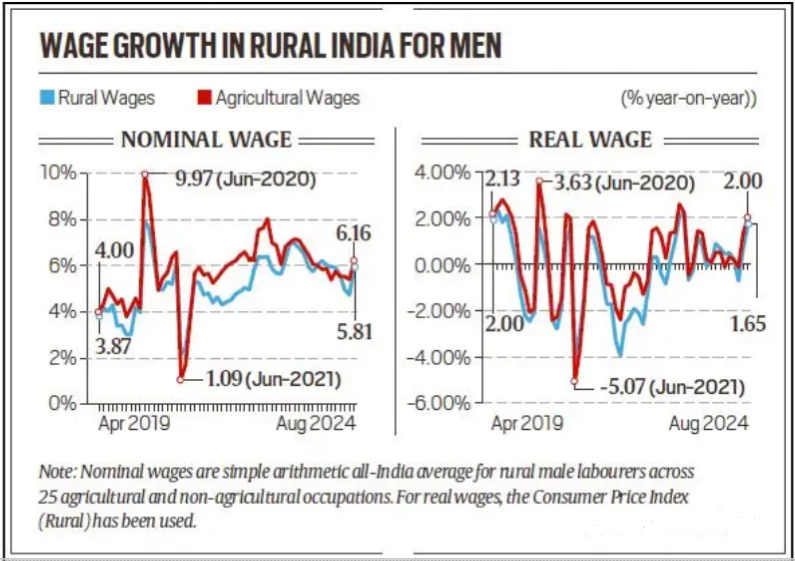Despite India’s economic growth, rural wages have stagnated, with nominal increases barely outpacing inflation and real wage growth remaining minimal, especially in agriculture.
Key Findings on Growth and Rural Wages in India

- Economic Growth vs. Wage Stagnation: Despite GDP growth averaging 4.6% (2019-24) and 7.8% in recent years, rural wages remain largely stagnant, especially after inflation adjustments.
- Agriculture grew by 4.2% and 3.6% in these respective periods.
- Rural Wage Growth Trends: The Labour Bureau’s data shows nominal rural wage growth at 5.2% (5.8% in agriculture), but inflation-adjusted real wage growth is -0.4% for rural and 0.2% for agricultural wages.
- Rising Labour Force Participation: Rural women’s participation rose significantly from 26.4% (2018-19) to 47.6% (2023-24), spurred by government schemes like Ujjwala and Har Ghar Jal.
- Labour Supply Impact: Increased rural female workforce participation has expanded labour supply, creating downward pressure on wages.
- Demand for Labour: Women primarily find work in agriculture, as economic growth increasingly shifts to capital-intensive sectors, limiting wage gains.
- Income Transfer Schemes: Income support programs, like Maharashtra’s Ladki Bahin Yojana, offer supplementary cash transfers, partially mitigating stagnant wages
Enroll now for UPSC Online Classes
Nominal Wage vs Real Wage
| Aspect |
Nominal Wage |
Real Wage |
| Adjustment for Inflation |
- Not adjusted for inflation
|
|
| Reflects |
- Current wage in money terms
|
|
| Purchasing Power |
- Does not account for changes in purchasing power due to inflation or deflation
|
- Accounts for inflation, giving a more accurate picture of an employee’s purchasing ability
|
| Variation with Inflation |
- If inflation rises, the purchasing power of the nominal wage declines
|
- Real wage declines if inflation rises unless the nominal wage is increased proportionately.
|
| Example |
- If a person earns ₹50,000 per month today, this is their nominal wage, regardless of the changes in prices of goods and services.
|
- If a person earns ₹50,000, but inflation is 10%, their real wage would effectively be ₹45,000 in terms of purchasing power.
|
![]() 4 Nov 2024
4 Nov 2024


